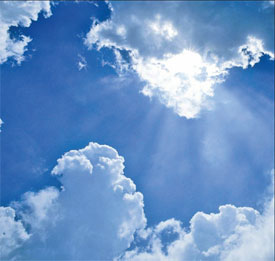|

Science
1.Why does ice float in water?
2 . Why are clouds white?
3. How did salt get into the ocean?
4.Why do trees grow at a slow rate?
5.What are the zones of the Earth?
[Answers]
Science
 1.
Ice is less dense than liquid water.Water is a member of a very
exclusive group of substances that are less dense as a solid than as a
liquid. It is very important that ice floats and has numerous biological
impacts; namely, all life on earth. Most substances will contract as
they cool, their individual molecules slowing down and "staying put"
until finally forming a solid. Water will also do this - up to a point.
As the temperature of water drops, the molecules slow down and contract
just like any other substance. But once it reaches 4 degrees Celsius,
water will start to expand. The reason water does this lies in its
hydrogen bonds. 1.
Ice is less dense than liquid water.Water is a member of a very
exclusive group of substances that are less dense as a solid than as a
liquid. It is very important that ice floats and has numerous biological
impacts; namely, all life on earth. Most substances will contract as
they cool, their individual molecules slowing down and "staying put"
until finally forming a solid. Water will also do this - up to a point.
As the temperature of water drops, the molecules slow down and contract
just like any other substance. But once it reaches 4 degrees Celsius,
water will start to expand. The reason water does this lies in its
hydrogen bonds.
2. Not all clouds are pure white, however, for those that are white,
it is due to their altitude and the reflection of sunlight.For example,
a cirrus cloud has an altitude of approximately eight km above sea
level. At such extreme altitudes all high-level clouds are made up only
of ice crystals, as the water vapour from which they are initially
formed has frozen. The ice crystals reflect sunlight. When flying above
clouds during the day, they are always bright white. When we get dark
clouds, they are so thick that they soak up most of the sunlight or
reflect it upwards, and so things aren't as bright below. Storm clouds
are the thickest clouds, and look the darkest from down below, though
they still look bright white if we see them from above. Grey colour of
the clouds is caused by higher clouds casting their shadow on
lower-based clouds, or that the clouds are so dense that their top parts
absorb most of the sunlight, casting their own shadow along their base,
making them dark on the bottom.
3. As rocks weather and erode, sediments find their way to the seas
and oceans through streams and rivers, taking minerals such as salts
with them. These are dissolved in the water and do not evaporate, so
that the salinity of seawater increases over time. It has been a gradual
process and has taken billions of years to reach the salinity we have
today. Other sources include hydrothermal vents and salt beds at the
bottom of the ocean. The oceans usually contain 35 parts of salts for
every 1000 parts of sea water. This is lower in some places where there
is a lot of fresh water coming into the ocean. It is higher where the
Sun is very strong and evaporates more of the water. When all the water
is gone, the salts are left behind as solid, white crystals.
 4.There
are many factors for this: soil, heat, water and other plant factors. 4.There
are many factors for this: soil, heat, water and other plant factors.
5. The five zones of the earth are Arctic Circle, Tropic of Cancer,
The Equator, Tropic of Capricorn, and the Antarctic Circle.There is also
the hemisphere zones (4);Northern Hemisphere,Southern Hemisphere,Eastern
Hemisphere and Western Hemisphere |

